The Headless Way
Direct access to our essential nature
is freely available to everyone here and now
is freely available to everyone here and now
The Hierarchy
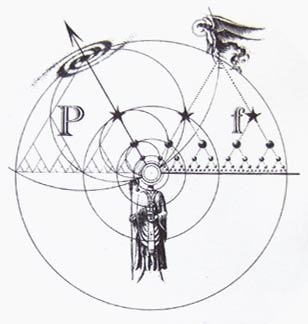
The Hierarchy of Heaven and Earth
A View by Richard LangMY PERSONAL IDENTITY
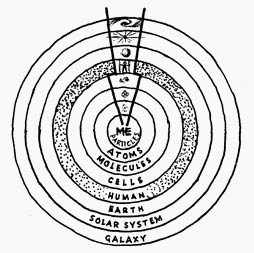
The View In
What I am depends on the range from which I am observed.For an observer looking at me from several feet I am a human being.
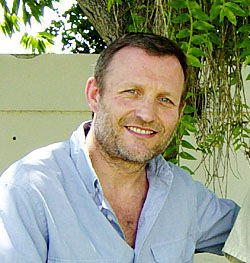 At this range I am one person amongst about six and a half billion others on this planet. I was conceived in my mother's womb, evolving from a fertilized egg through fish-like and reptilian forms into a human foetus (recapitulating the evolutionary journey of Life), then born as a human baby. Gradually I took on the arts and crafts of being human, learning to smile, crawl, walk and talk. As an adult I continue developing, taking on a range of responsibilities. If I live long then working life will be followed by the active retirement of second youth with its partial surrender of responsibilities and powers, then by second childhood and second infancy, and finally by the grave.
At this range I am one person amongst about six and a half billion others on this planet. I was conceived in my mother's womb, evolving from a fertilized egg through fish-like and reptilian forms into a human foetus (recapitulating the evolutionary journey of Life), then born as a human baby. Gradually I took on the arts and crafts of being human, learning to smile, crawl, walk and talk. As an adult I continue developing, taking on a range of responsibilities. If I live long then working life will be followed by the active retirement of second youth with its partial surrender of responsibilities and powers, then by second childhood and second infancy, and finally by the grave.The View Out
What am I from my own point of view? At centre I am not a person. I am aware space or capacity. (To test this for yourself, do the Experiments.)What am I capacity for?
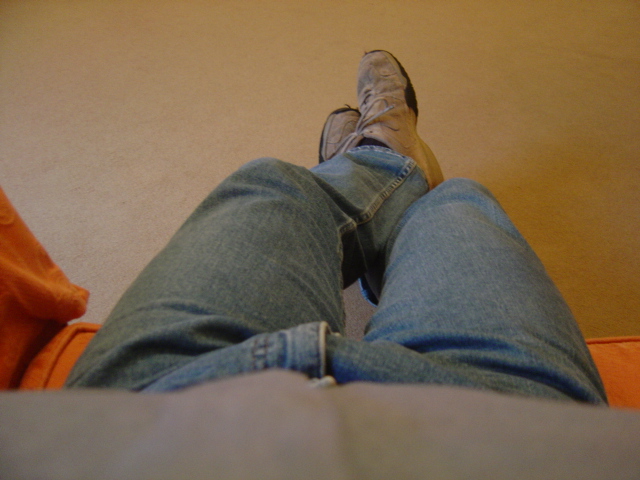
Looking out a small distance from my centre I am capacity for my (headless) body...
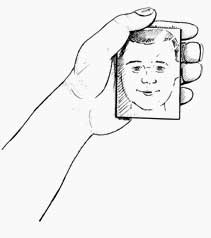
...my face in the mirror...

...and other people.
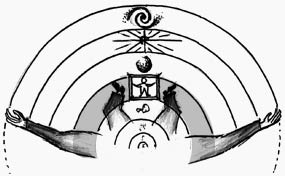
At this range I am looking out into my human zone.
Trading Faces

When I meet a friend I see her face here in my no-face - I see her human appearance here in my empty (non-human) centre...

...and she sees my human face there in her empty (non-human) centre - we trade faces. I have her face, she has my face.
I am her and she is me.
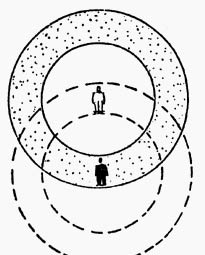
Put another way: in this diagram the upper circle represents my friend, the lower circle myself. The white figure is what I look like at a few feet. My human appearance is not central to me but manifests over there in the centre of my friend's circle. In other words, in her space she finds my face. Whereas at my centre, in the space here that I am, I find her face, her appearance. I am room for her, and she is room for me - we trade appearances.
Reflection And Self-Consciousness
Not only do I see my friend's face here in my empty centre but I tell her about it: both what it looks like and where it is. I reflect it back to her. Accepting what I say, my friend then sees (imagines) herself as I see her, taking on board that her face is where she is, even though she does not see it there. In this way she becomes self-conscious. In the same way my friend not only tells me about my face but also where it is. She reflects my face back to me. I then see (imagine) myself as she sees me, taking on board that my face is here - even though I don't see it here, and even though my friend would, if she approached me, find my face replaced by many other things (cells, molecules and so on) and finally by nothing at all. If she were then able to turn round and look out of my nothingness with me, she would find me to be an empty receptacle for what I call her face. Each of us contains the other and no one is simply here or there.Self And Society
I become human by being capacity for human society and then taking on board how that society sees me. I can only know I am a person in the company of other people, for that is where I become aware of my personhood. My life is the life that others live in me (since I am capacity for them) and that I live in others (since they are capacity for me). Others then reflect back how they see me - a view which I take on, so becoming self-conscious. Self and society are inseparable and co-dependent.Three Stages Of Life
I have not always been aware that I am capacity for others; I used to see myself only as others saw me, as a person face to face with and separate from others. However, this was not my original view of myself either - this self-conscious, external view of myself was an acquired view. Nor need this stage be the last stage in anyone's development. There are potentially three main stages in life: first, your view of yourself only from your own point of view, your view out; second, the view of yourself only from other people's points of view, the view in; and finally an integration of these two views. The three stages are: the baby, the adult and the seer. (I will also describe the important transitional stage of the child.)Stage One - The Baby (The View Out)
 Headless for myself, I have no awareness yet of my appearance in the eyes of others - no awareness yet of their view of me, the view in. I don't yet know I am a thing - 'a baby' - and have no idea that 'I' was born or will die. I am capacity for the world, single-eyed, at large, timeless; without thinking of myself in these or any other terms. (I do not yet have language.) The world I am capacity for includes my headless body, feelings, sounds, food, other people, animals, plants... I have not yet learned where I stop and the rest of the world begins, nor about yesterday and tomorrow, other places, nor even 'other' people; at least in any developed way. When I look in a mirror I learn to see a 'baby' there but don't yet think of it as myself. I am capacity for that face, just as I am capacity for the faces of others, the sound of birds, the feel of the wind, the taste of milk; without identifying with any of these things.
Headless for myself, I have no awareness yet of my appearance in the eyes of others - no awareness yet of their view of me, the view in. I don't yet know I am a thing - 'a baby' - and have no idea that 'I' was born or will die. I am capacity for the world, single-eyed, at large, timeless; without thinking of myself in these or any other terms. (I do not yet have language.) The world I am capacity for includes my headless body, feelings, sounds, food, other people, animals, plants... I have not yet learned where I stop and the rest of the world begins, nor about yesterday and tomorrow, other places, nor even 'other' people; at least in any developed way. When I look in a mirror I learn to see a 'baby' there but don't yet think of it as myself. I am capacity for that face, just as I am capacity for the faces of others, the sound of birds, the feel of the wind, the taste of milk; without identifying with any of these things.The Child (Transitional Stage)
From day one people around me tell me who I am; they reflect back what they see of me. "Nice little baby!" Of course to begin with I don't understand their words, but they don't fit anyway. I am not a little baby - I am capacity for the world! I don't yet take on board their view of me.As my grasp of language grows I begin learning to see myself as others see me. In imagination I travel several feet away from myself and, turning round, observe myself from that distance through the eyes of others: with a head on my shoulders. Gradually I learn that the infant in the mirror is not another infant but is myself - it is (with a few adjustments) what others see when they look in my direction. Although from my point of view I am headless, spacious, at large, nobody in my world confirms this private side of me. In fact if I mention it, others laugh at me. So I begin to overlook and discount my own spacious view of myself. I start imposing here on my central facelessness the face I see there in the mirror, the face that others tell me is here, even though I have never see it here. In the company of others I see (imagine) myself face to face with them, my imagined face here confronting their perceived faces there. I am learning to play a game - the Face Game - though I'm unaware it's a game. The essence of this game is pretending I have a face where I don't have one, and taking this on board so thoroughly that I profoundly believe it.
My growing capacity to see myself as others see me distinguishes me from animals in the sense that animals do not become self-consciousness like humans. Cats don't lie around imagining how they appear to other cats - never mind then going on to admire (or hate) their self-image! (See a short BBC video in this article about becoming self-conscious.)
Why do I start making this shift to seeing myself as others see me? Now that as a child I am able to do more things physically and through language can communicate better, I want to be a part of what is going on around me, want to join in and enjoy the benefits of being human, want to be a full member of society. The basic condition for participating is knowing who I am in the eyes of others and taking responsibility for myself as that person. So I begin accepting I am a thing separate from all other things. What choice is there anyway? No alternative is offered. Besides, to reject being the one in the mirror and so not to accept the way others see me would surely be an experience of profound isolation and meaninglessness; not that I would know it.
Even though I am taking on board here what I am for others there, as a child my self-awareness is still fragmentary. Much of the time I forget about what I look like - my self-image is not yet firmly established in my mind. In those blessed childhood hours when I am blissfully unaware of my image, how bright and vivid the world appears. Looking at a flower I see the flower clearly with no idea of a face in the way, no self apparently distancing me from those petals, that scent, that texture. I see the flower, not myself seeing the flower. Without describing it in these terms, I am the flower. When I am playing, with other children or alone, my full attention goes into what I am doing - half my attention is not yet bound up with what I look like. Undivided in this way I have plenty of energy. Not yet over-concerned with what others think about me, I am original and inventive in my play, carefree, making things up as I go along, inspiration flowing effortlessly from the no-mind within. Since I don't yet think of myself as inside a human box, or inside any box, it's easy for me to experiment with being all kinds of things: one moment I am a bird, the next a lion or a train. But then mum or dad comes along and tells me to behave: "You're not a bird, you're a child!" Suddenly I am reminded of their view of me again. But (to their frustration!) just as suddenly I forget and am a bird again - for the time being anyway! I enjoy easy intimacy with others because I am capacity for them, unaware in these moments of being 'face to face' with them, of being distant from them, of being a thing up against and excluding them. Not constricted yet by worrying about impressing others, I relate simply and openly.
On the road towards adulthood, childhood gives way to adolescence, the time when the necessity for establishing my identity intensifies. "Who am I? Where do I belong? What do I want to do in my life?" At this time of life the question is not really, "Who am I for myself at centre?" but, "Who am I in relation to others in the world?" During this stage I don't want to be a 'nobody', a 'non-entity', I want to be a 'somebody': a special somebody. Appropriately so. My view of myself at centre where I am no-thing, capacity, silence - this is not in the forefront of my consciousness. What is important at this stage is recognizing my objective, separate identity and finding my unique role in the world.
Stage Two - The Adult (The View In)
As an adult I am now self-conscious practically all the time: I see myself as others see me. Even if I am not consciously thinking about what I look like, self-consciousness is my 'default position'. Playing the Face Game, I identify automatically with my appearance. Another person has only to glance at me and I feel under inspection or on show, conscious of my appearance in some way or other. So deeply am I convinced I am what I look like that I dismiss as mad the idea of having no head, of being at large, of being capacity for others. I repress from consciousness my own point of view. When I look in the mirror I have no doubt I am that person. I am sure I am face to face with others, that I was born and will die, that I am 'only human' - I am not a bird, or a lion, or God. In short, I identify with my appearance and ignore being capacity. All my relationships and responses are based on this view of myself. I have shrunk from being capacity for all things (stage one) to being just one thing up against all other things (stage two).On the one hand this enables me to function in the adult world and enjoy tremendous benefits. I am now aware of being an individual and aware of the adventure of my life - I am a unique, self-conscious member of society. (I couldn't be a member of society if I were not self-conscious. Stuck in the first stage I would need institutional care.)
On the other hand, deep down I feel something isn't quite right. Something is missing. The denial and repression of my central spaciousness casts a shadow over my life. Though I have not actually lost my spaciousness, I feel as though I have, without quite knowing what I have lost. As a baby I enjoyed being the timeless centre and owner of the world, at large, un-separate from anything, without knowing any other way of being. Now I am a brief flash in a cosmos that by and large pays me no attention, that keeps its distance. No wonder if I feel abandoned and excluded, unimportant and unrecognized, lost and meaningless, angry and depressed ... And no surprise if I spend my time trying to regain my importance and meaning in the only ways I know how, through power, wealth, fame, love, sex... From being the sole owner of the world I am reduced to owning a pittance. From being everything, I am a speck of dust. A veil has fallen over the enchanted, beautiful world I knew as a child. My abandon and enthusiasm has been replaced by caution and indifference, intimacy by distance, timelessness by change and death. Of course I feel cheated and robbed - I have been. Of course deep down I am afraid - countless swords of Damocles hang over my head. I search everywhere for the peace I vaguely remember knowing as an innocent baby; and the lightness, the joy, the wonder. Dimly recalling my original openness towards others, the love that excluded nothing and no one, I search for it everywhere. And so on. The loss of Who I really am affects every area of my life.
To the extent I don't suffer in these ways I remain "a child at heart", more or less unconsciously in touch with my spaciousness, with Who I really am.
Fortunately there is a further stage.
Stage Three - The Seer (Integrating The View In and The View Out)
One day I see Who I really am. I realize there is a difference between what I am for others and what I am for myself. I take seriously what I see; that from my own point of view I am the headless source and container of the world!At the same time, unlike the baby, I am also aware I have an appearance; I still recognize myself in the mirror! I know I am an individual in society with a special contribution to make.
Thus I realize I have two sides: for others (and for myself self-reflectively) I am a person with a face, 'a self-in-society'; for myself I am space: all faces, all selves are in me. This realization combines the baby's view (the view out) and the adult's view (the view in).
When I start living in conscious awareness of Who I really am, gradually my life is profoundly affected. The stress that arises from seeing myself only from outside - as a vulnerable thing - begins to ease now that I see I am absolutely and always safe as no-thing/everything. Seeing that all things are within me I realize I am infinitely rich, on intimate terms with everyone and everything, the immortal source of all things... From feeling hopelessly lost I feel increasingly at home, anywhere and everywhere. As I experiment living in conscious awareness of Who I really am, I discover the infinite wisdom and goodness of my True Nature.
The truth shall set you free. Jesus
Go to My Cellular Identity
back to top


















